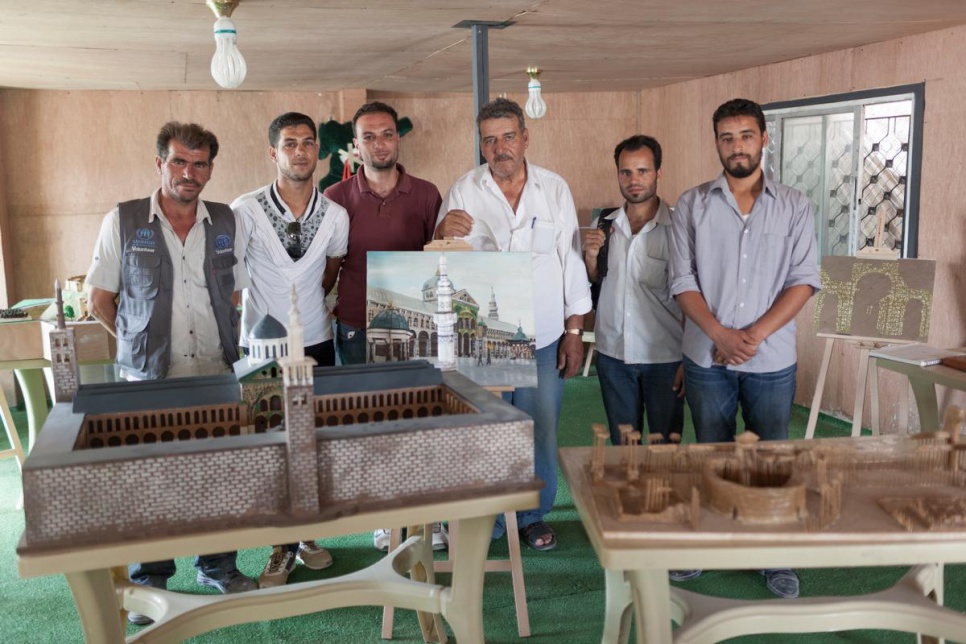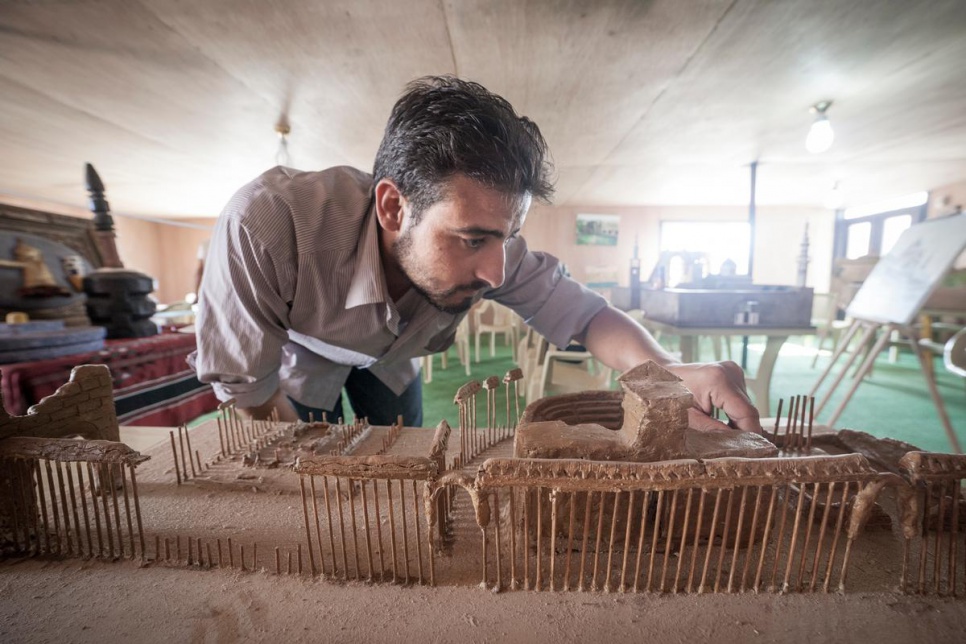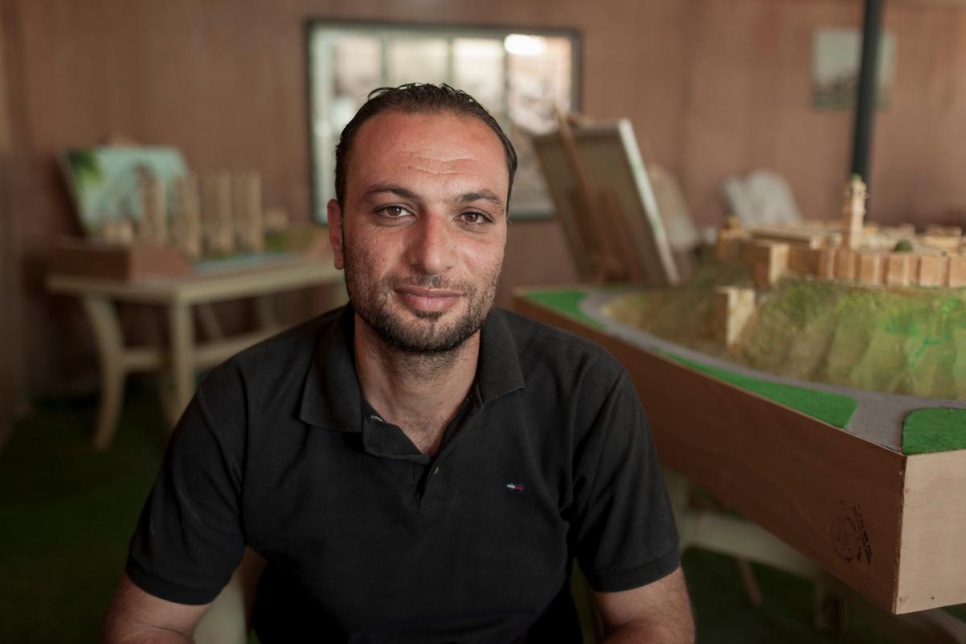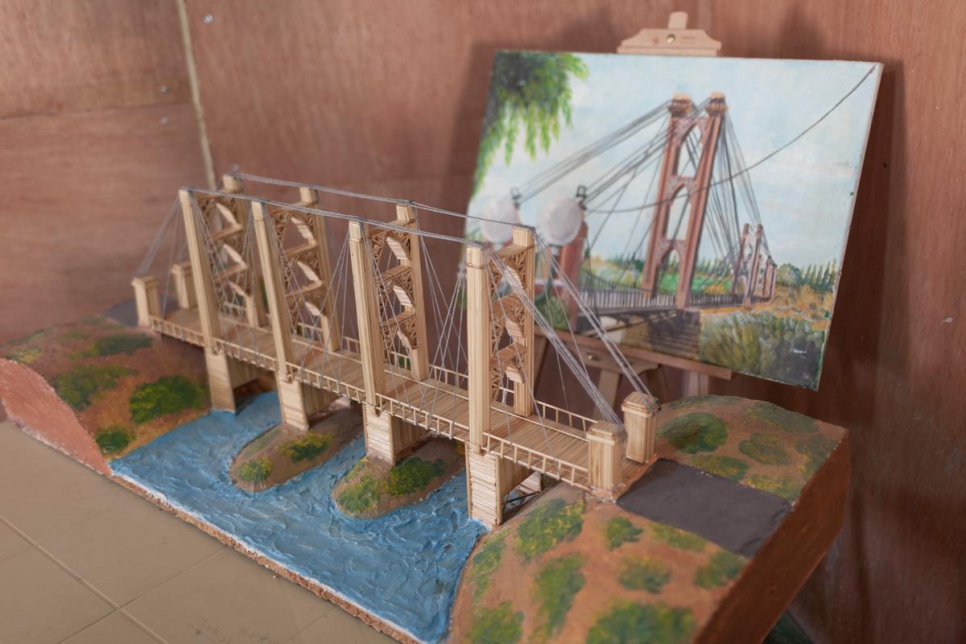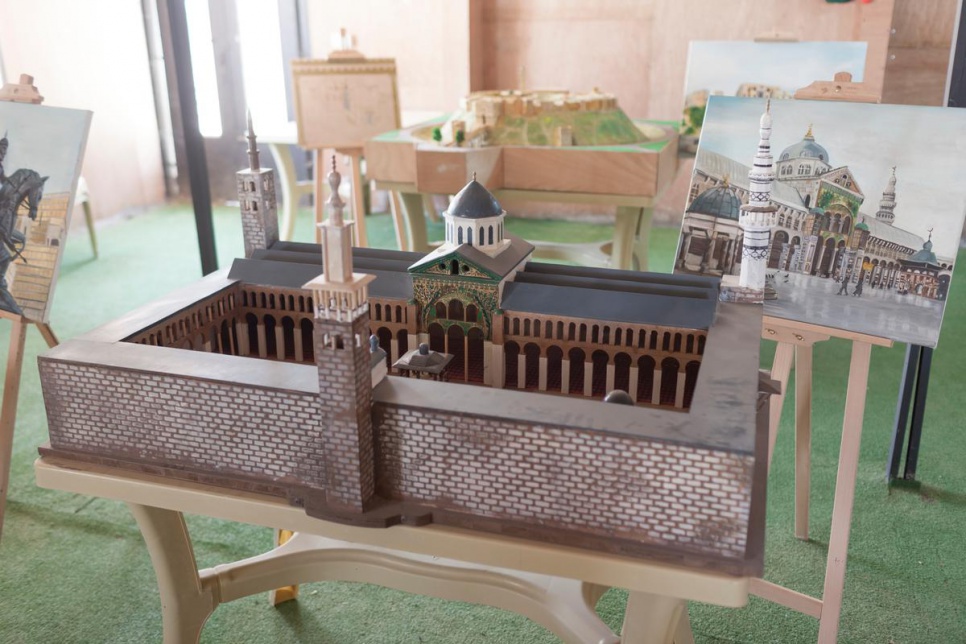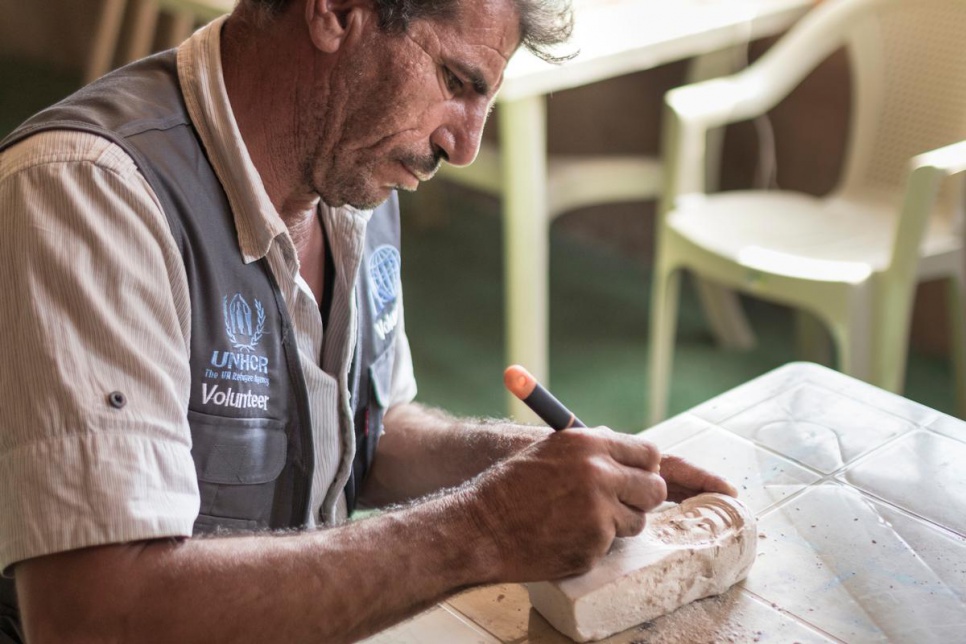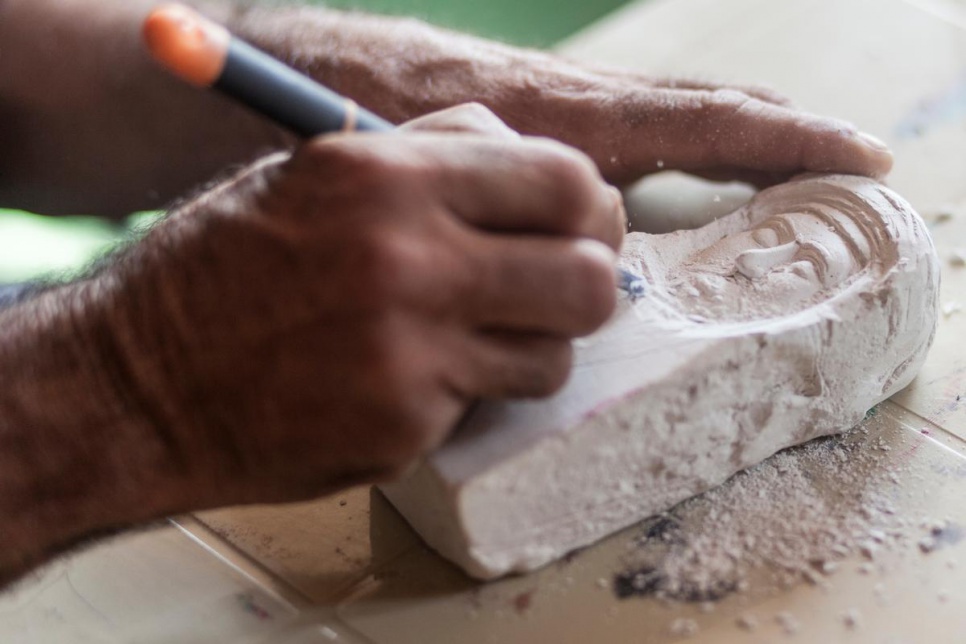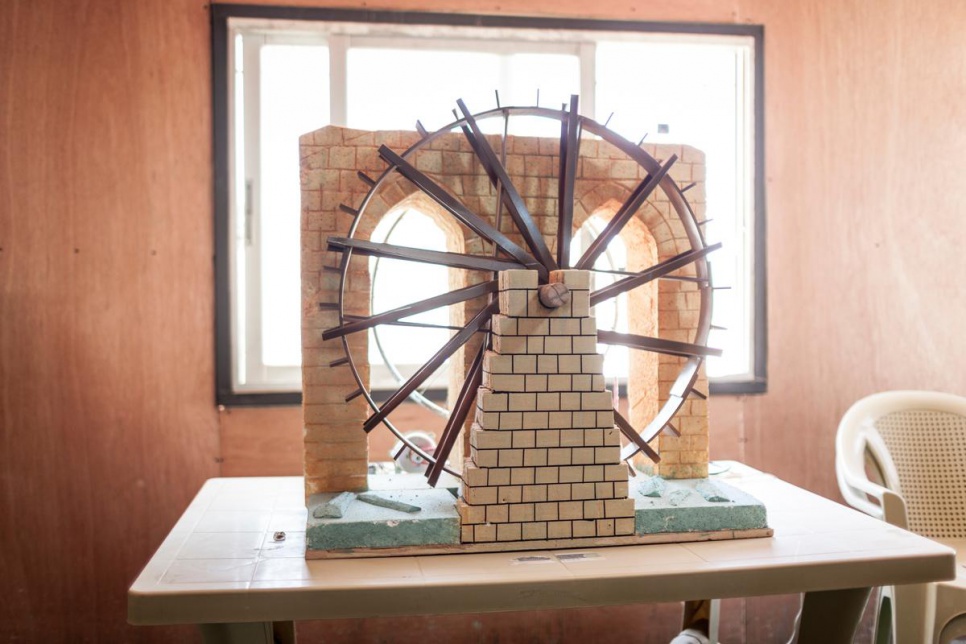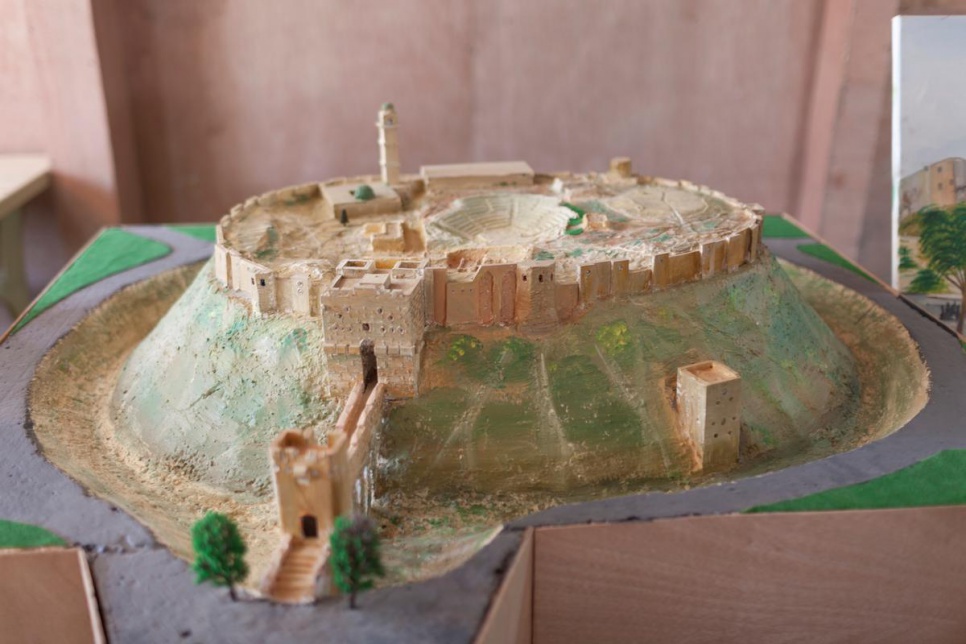By: Christopher Herwig and Charlie Dunmore | 5 January 2016
The world has looked on in disbelief at the demolition of iconic landmarks in the ancient city of Palmyra in Syria – a shocking illustration of the chaos inflicted on the country and its people by years of war.
-
In Jordan's Za'atari refugee camp a group of Syrian artists is working with basic tools and materials sourced from around the camp. They are using local stone, polystyrene and discarded wood, to build models and sculptures of iconic sites including Palmyra and the Krak des Chevaliers castle in Homs. "We chose this project to highlight what is happening in Syria, because many of these sites are under threat or have already been destroyed," says project coordinator Ahmad Hariri, from Dara'a (third from left). © UNHCR/Christopher Herwig
-
Mahmoud Hariri, 25, was an art teacher and painter in Syria before seeking refuge in Za'atari in 2013. "When I first arrived I didn't think I would continue my work as I only expected to be here for a week or two. But when I realised it would be years, I knew I had to start again or lose my skills."
Mahmoud built a model of Palmyra using clay and wooden kebab skewers. While working on it, he learned that the site had fallen under the control of armed groups.
"I'm very worried about what is happening. This site represents our history and culture, not just for Syrians but all of humanity. If it is destroyed it can never be rebuilt." © UNHCR/Christopher Herwig
-
The artists displayed their architectural models at a community centre run jointly by UNHCR and an NGO partner, International Relief and Development. They have also been shown at an exhibition in the Jordanian capital, Amman.
Mahmoud, like the other artists, comes from Dara'a. He hopes that Za'atari residents who see the exhibition will stay connected with the country and culture they have left behind. "This is a way for them not to forget. As artists, we have an important role to play. A lot of what we know about ancient civilizations or prehistoric people is preserved through their art -- Egyptian hieroglyphs or cave paintings." © UNHCR/Christopher Herwig
-
Ahmad Hariri, who initially brought the group together and helps source their materials, hopes the project will help educate children in the camp about their homeland.
""There are lots of kids living here who have never seen Syria or who have no memory of it. They know more about Jordan than about their own country." The project has also given the artists a sense of purpose. "By doing this work, they feel like they are at least doing something to preserve their culture."" © UNHCR/Christopher Herwig
-
Erected for pedestrians in 1927, the Deir ez-Zor suspension bridge spanned the Euphrates River in north-eastern Syria. It was destroyed by shelling in 2013, but is remembered in this miniature replica, which was shown at the community centre in Za'atari. © UNHCR/Christopher Herwig
-
The Umayyad Mosque in Damascus, built 1,300 years ago, is said to be one of the largest and oldest mosques in the world. It inspired one of the miniature replicas displayed at the community centre in Za'atari camp. © UNHCR/Christopher Herwig
-
Ismail Hariri, 44, began sculpting at an early age. He worked as an interior designer before the conflict forced him to flee to Jordan with his wife and children in 2013.
After arriving in Za'atari, he was reluctant to take up sculpting again. But after hearing about the project he rediscovered his passion. He has been asked by UNHCR partner International Relief and Development to run art classes for 44 children at the community centre. © UNHCR/Christopher Herwig
-
Ismail made several sculptures for the exhibition. His favourite depicts the Nabatean gate and arch at Bosra, near Dara'a. Like the original, it is made from volcanic stone, which he found in the camp.
"It was a large stone, and it took me two months to finish it, working with the simple tools I could find. It's the first thing I've made for a long time. For the first few days I hit my hand more than I hit the stone." © UNHCR/Christopher Herwig
-
The Norias of Hama, constructed over 750 years ago along the Orontes River, used the power of the current to lift pots of water to higher elevation. This miniature replica was displayed at the community centre in Za'atari. © UNHCR/Christopher Herwig
-
Famed military and political leader Ayyubid Sultan Saladin also features among the replicas created by the artists. A huge bronze statue of the man who successfully led Muslim opposition to the European Crusaders in the Levant during the 12th century has stood in front of the medieval Citadel of Damascus since 1993. The statue was unveiled to mark the 800th anniversary of Saladin's death. The Ancient City of Damascus is the only one of Syria's six UNESCO World Heritage Sites that has not suffered significant damage during the conflict. © UNHCR/Christopher Herwig
-
The Citadel of Aleppo is one of the miniature replicas created by the artists. The medieval structure is one of the oldest and largest castles in the world, and it towers over the old city from a strategic position atop a 40-metre-high plateau. While construction of the current fortress dates from the 12th and 13th centuries A.D., the site itself contains evidence of occupation by civilizations dating back millennia. Declared a UNESCO World Heritage Site in 1986 as part of the Ancient City of Aleppo, the citadel was placed on a list of endangered sites in 2013 as a result of the threat posed by the conflict in Syria. It has been one of the country's most popular tourist destinations, but since combatants began using the fortress as an artillery battery in 2012, it has suffered significant damage, the full extent of which is still unknown. © UNHCR/Christopher Herwig
For millions of Syrians in exile who have already lost their homes, livelihoods and loved ones, the destruction of their country's cultural heritage is a further cruel twist in a conflict that threatens to rob them of their past as well as their futures.
Outraged but powerless to prevent the havoc being done in their homeland, a group of Syrian artists living in Jordan's Za'atari refugee camp have used their skills and whatever materials they can find to build models of the landmarks that embody Syria's long and rich history.
While many of the sites have been damaged or destroyed in the fighting, the group hopes that its painstaking recreations will bring attention to the threat facing Syria's cultural monuments and help fellow refugees to remember the homeland they were forced to leave behind.

